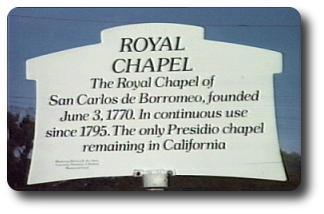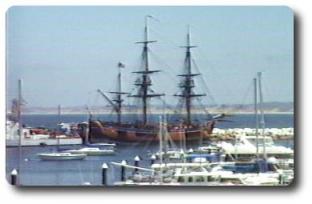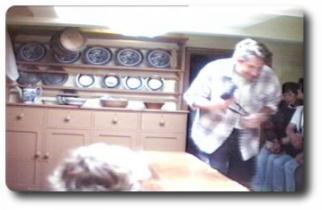Monterey
I was booked into the Marriott, but didn't know exactly where it
was, other than being on "Calle Principale". (I don't know Spanish, but
my guess is that translates to "Main Street"). It wasn't too hard to find,
as I think it is the tallest building in Monterey, being all of 10 floors.
Finding the entrance took a little navigating, as there are a number of
one way streets, and a couple of 45 degree corners nearby, just to add
to the confusion.
I checked in, then took the car off to
Pacific Grove,
which is all of a 10 minute drive. That is where my employer
Jeff is located. Even though it was Saturday afternoon, my guess was that
he would be in the office. Which was a good guess. In fact, my timing
was excellent, as
his son Victor was due to arrive (Victor works for Intel in Silicon Valley),
so we went off for coffee and social banter. A pleasant way to spend an
afternoon. By the time I returned to the Marriott, the conference registration
desk was open, so I registered and headed back to my room to look it all
over.
The conference format was three days of tutorials, followed by 3 days
of conference. When I made the hotel reservation I was not sure whether
I would attend any tutorials, so booked the hotel for 7 nights in case.
As it turned out, none of them appealed enough to justify the $300/day
cost. So I had three free days - Sunday to Tuesday, inclusive.
Sunday I decided to tour
Monterey.
I have not done that before, even though I have been to Pacific Grove a
number of times. (The two cities run into one another). Monterey is a coastal
city, located on
(surprise) Monterey Bay (where John Denver's plane crashed when he
ran out of fuel!). It used to be a major fish cannery, but that pretty
much expired in the 50s. It was also home to (author)
John Steinbeck,
who immortalised Cannery Row in a novel of that name. His only work
that I know about is "The Grapes of Wrath".
Monterey also has an
aquarium
of note. There is a very deep canyon out in the bay, being many thousands
of feet deep. There is still a fishing fleet, though minuscule by comparison
with what it used to be. And there is the traditional fisherman's wharf
area, which had little appeal to me. That part of town is also the historic
part, and there are a number of old buildings around, some in private hands,
others as museums. There's also an interesting nautical museum.
Monterey has the uncommon distinction of having been part of three countries.
It was claimed for Spain, then became part of Mexico when Mexico won independence
from Spain, then part of the US when it defeated Mexico in the Spanish
(Mexican?) American war. The Spanish arrived in Monterey in 1770, when
an explorer (whose name I don't remember) and Father Junipero Serra moved
along the coast from the Gulf of California (in Mexico) establishing mission
churches every 20 miles (32 km) or so. That was the distance considered
a reasonable day's ride in the 1770s, when this was happening. Many of
the Spanish names of well known California cities came from the names of
the missions - San Diego, San Clemente, Los Angeles, San Louis Obispo,
San Simeon (Randolph Hearst's castle), Monterey, San Jose, Santa Clara
and San Francisco. There were quite a few others - these are just the ones
I remember. Oh, yes, San Juan Capistrano too.
 The original church in Monterey was built in 1770,
but it was a temporary structure replaced with the current one,
San Carlos Cathedral,
in 1792. It's not a church of great architectural
significance, but considering that it is still standing after 200 years,
in an earthquake area, is quite a compliment to its builders.
The original church in Monterey was built in 1770,
but it was a temporary structure replaced with the current one,
San Carlos Cathedral,
in 1792. It's not a church of great architectural
significance, but considering that it is still standing after 200 years,
in an earthquake area, is quite a compliment to its builders.
 When I arrived in Monterey, I picked up a brochure advertising the US west
coast journey of
The New Endeavour,
the Perth made replica of Captain Cook's ship. I was in luck - it's last
day in Monterey was Sunday. So I went on a tour. Quite amazing - it's 109
feet long - 33 metres! Less than a Manly Ferry. And Cook and his crew sailed
around the world in it.
When I arrived in Monterey, I picked up a brochure advertising the US west
coast journey of
The New Endeavour,
the Perth made replica of Captain Cook's ship. I was in luck - it's last
day in Monterey was Sunday. So I went on a tour. Quite amazing - it's 109
feet long - 33 metres! Less than a Manly Ferry. And Cook and his crew sailed
around the world in it.
 And it was very cramped inside, as can be seen from this image of the
Officer's Mess.
People were shorter in those days, but still it must have been hard for
the crew. Especially the Marines, whose sleeping area was not tall enough
to stand in! Of course, the captain and Gentleman, had almost reasonable
accommodations in the rear of the ship. Banks put up a considerable amount
of money to fund the expedition, so he and Cook had the rear room on the
ship, which had a table and heater all of its own. Each had private sleeping
quarters.
And it was very cramped inside, as can be seen from this image of the
Officer's Mess.
People were shorter in those days, but still it must have been hard for
the crew. Especially the Marines, whose sleeping area was not tall enough
to stand in! Of course, the captain and Gentleman, had almost reasonable
accommodations in the rear of the ship. Banks put up a considerable amount
of money to fund the expedition, so he and Cook had the rear room on the
ship, which had a table and heater all of its own. Each had private sleeping
quarters.
 The original church in Monterey was built in 1770,
but it was a temporary structure replaced with the current one,
San Carlos Cathedral,
in 1792. It's not a church of great architectural
significance, but considering that it is still standing after 200 years,
in an earthquake area, is quite a compliment to its builders.
The original church in Monterey was built in 1770,
but it was a temporary structure replaced with the current one,
San Carlos Cathedral,
in 1792. It's not a church of great architectural
significance, but considering that it is still standing after 200 years,
in an earthquake area, is quite a compliment to its builders.

